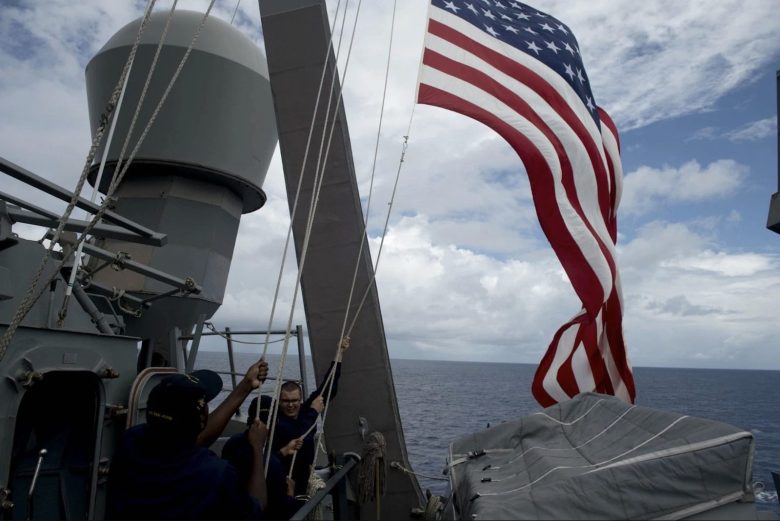MANILA – With the Covid-19 pandemic mostly contained in China and now wreaking havoc on the United States, security analysts are closely watching Beijing’s military moves in the hotly contested South China Sea.
In recent days, China has conducted military drills and deployed large-scale military assets to the maritime area while at the same time officially celebrating strides made in exploiting disputed energy resources in the fossil fuel-rich sea.
While some see China’s nationalistic messaging as a bid to rally its people during difficult Covid-19 times, others view the increasingly aggressive naval maneuvers as a bid to exploit America’s weakened condition to secure new advantage in the hot spot theater.
Rival Southeast Asian claimants are also in a compromised strategic position as they contend with worsening Covid-19 outbreaks.
The Philippines and Malaysia, both at territorial loggerheads with China in the sea, have both recently placed their administrative and commercial capitals under weeks-long, military-enforced lockdowns.
Philippine President Rodrigo Duterte and top security officials including Defense Secretary Delfin Lorenzana are in self-imposed quarantines, with Armed Forces of the Philippines (AFP) chief General Felimon Santos Jr recently testing positive for Covid-19.

The US, the long-term guarantor of the region’s law-based order, is now grappling with the world’s worst outbreak with nearly 190,000 cases, forcing the White House to implement extraordinary measures including the largest economic stimulus package in its history.
The Pentagon, meanwhile, has been mobilized to help combat the epidemic under the Defense Production Act, which allows the US military to provide critical health services, and produce and transfer desperately-needed medical equipment to civilian agencies and facilities.
China’s bid to opportunize on the Covid-19 crisis which originated in its Wuhan city has been on display on multiple fronts. On one hand, Beijing has launched a concerted attempt to reshape the pandemic’s narrative, including the bizarre suggestion by top Chinese officials that the US military planted the virus in China.
This has gone hand-in-hand with attempts to drive a diplomatic wedge between the US and its traditional transatlantic allies, some of which have recently committed naval vessels to US-led freedom of navigation operations in the South China Sea.
China has bid to highlight the US’s perfunctory travel ban on European virus-infected nations while it provided desperately needed medical equipment to worst-hit nations such as Italy and Spain, a gambit some are referring to as Beijing’s “face mask diplomacy.”
While trumpeting itself as a global leader at a time of crisis, Beijing is pressing ahead in expanding its strategic and economic footprints in the South China Sea.

According to China’s Ministry of Natural Resources, China recently conducted its most successful extraction of natural gas from gas hydrates both in terms of volume and production within a single day in a contested northern region of the sea.
The ministry trumpeted its “solid technical foundation for commercial exploitation” to become the first country in the South China Sea to exploit gas hydrates, mineral deposits at the bottom of oceans, by utilizing a horizontal well-drilling technique.
The production process ran between February 17 to March 18, just as the coronavirus epidemic began to ravage countries across the Western world.
China’s strides in energy development technology will likely only reinforce its bid to dominate, if not monopolize, vast untapped oil and gas deposits within its so-called ‘nine-dash’ line claim, which covers close to 85% of the South China Sea and overlaps with waters off Indonesia’s northern Natuna Islands.
In that direction, China has also recently conducted significant military drills in the disputed areas. These have included anti-submarine drills, held soon after the Pentagon deployed the US guided-missile destroyer USS McCampbell in a freedom of navigation operation in the sea before the coronavirus pandemic hit the US mainland with full force.
China’s People’s Liberation Army (PLA) has also flexed its naval muscles in the area through recent military drills led by the country’s first aircraft carrier, the Liaoning. Those followed on aircraft-carrier-led drills in the northern portions of the South China Sea.
“Under difficult sea conditions in the early spring in the Bohai Strait, multiple J-15 fighter jets took off from the flight deck of the Liaoning and successfully landed several hours later, indicating the success of the technique rehabilitation training for instructors at Naval Aviation University,” announced the PLA Daily on March 23.

“Training for war preparedness will not be stopped even in the middle of the Covid-19 epidemic, and the training of carrier-based fighter pilots must continue.”
China’s mouthpiece media has gone as far as to portray its latest sea exercises as part of fighting the pandemic.
“[A]n aircraft carrier is a large warship with many people concentrated in its cabins, making it vulnerable to infectious diseases. Being able to successfully conduct related missions indicated that the Liaoning has done a great job in controlling the epidemic,” Beijing-based naval expert Li Jie told the state-sponsored news portal Global Times.
Known for its jingoistic headlines and editorials, the Global Times proudly announced, “China’s second aircraft carrier, the Shandong, also reported zero COVID-19 cases on February 17,” without specifying the latest situation.
The US, for its part, has not completely abandoned the crucial theater.

The US Navy’s 7th fleet announced that its Arleigh Burke-class guided-missile destroyer, the USS Barry (DDG 52), conducted its own live drills in recent days, launching a missile in the South China Sea while conducting freedom of navigation operations in the Western Pacific.
“The Arleigh Burke-class guided-missile destroyer USS Barry – DDG 52 launched a missile during a live-fire exercise and conducted combat information center operations,” announced the US 7th fleet on its social media platforms last week.
“[USS] Barry is underway conducting operations in support of security and stability in the Indo-Pacific,” it said, while neither are clearly on the maritime area’s horizon.
Follow Asia Times Financial for the latest news and commentary on Asia’s fixed income markets.


